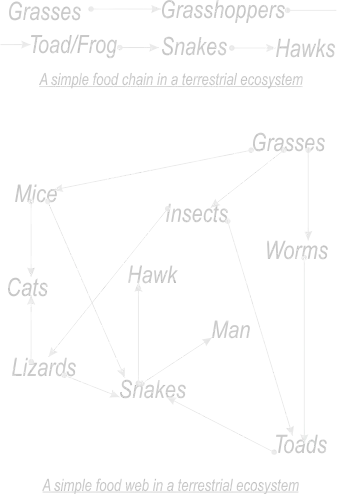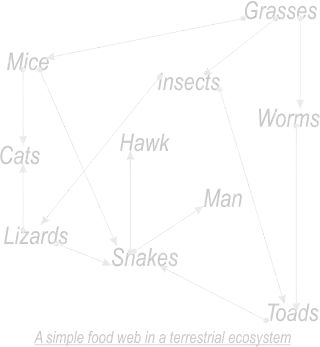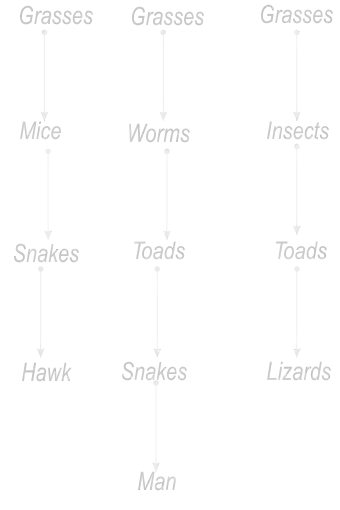Teaching Method
Asei Lesson Plan on Biology
Subject: Biology
Theme: Ecology of Population
Topic: Ecology
Sub Topic: Interaction of Living Organisms in an Ecosystem
Date: dd/mm/yyyy
Class: SSS 3
Duration: 35 Minutes
No of Learners: 30
Learning Objectives:
By the end of the lesson learners should be able to:Defined an Ecology
Defined an Ecosystem
Identify the major types of ecosystem
-
Terrestrial Ecosystem.
- Forest Ecosystem.
- Grassland Ecosystem.
- Desert Ecosystem.
- Aquatic Ecosystem
- Marine Ecosystem
- Freshwater Ecosystem
-
Terrestrial Ecosystem.
To construct simple food chains and food webs using organisms in their locality.
- Observation
- Construction
- Analysis
- Inference
- Collaboration
- Manipulation
- Communication
Ecology is the study of the inter-relationship between living organisms and their environment.
An ecosystem is a term coined from ecology and system. It is a natural unit that is made up of non-living things and living things, all of which interact constantly to form a stable system.

Rationale:
Students are aware that the ecosystem is composed of several organisms interacting in their environment. Their interaction is based or dependent on the flow of energy. It is therefore important for students to understand food chains and food webs.
Target Skills:
Prerequisite/ Previous knowledge:
Living and non-living things, Living organisms, internal and external structures of organisms, physiology and adaptations of organisms.Learning Materials:
Pictures of different organisms representing different trophic levels, Flip Chart, stickers, Manila chart, masking tapeReference Materials:
Biology A New Approach For Senior Secondary Schools and Colleges By E. O. Egho.Lesson Development:
| STAGE | TEACHER'S ACTIVITY | LEARNER'S ACTIVITY | LEARNING POINTS |
|---|---|---|---|
| INTRODUCTION full class session (5mins) |
The teacher introduces the lesson by posing a scenario of a flood where animals were displaced from their original environment. The task of the students now is to return the animals to their habitats.Activity 1: “Take them back home”Teacher issues out the materials to the pupils Questions
Teacher issues out the materials to the pupils |
Students use the given pictures of the organisms to fit them into the most suitable environment Students stick their charts on the wall and a brief class discussion of the activity ensues The students answer the question posed by the teacher.
|
Learner’s entry points. |
| STEP 1 5mins. Development and Grouping |
The teacher asks students to form groups and choose their leaders and secretaries. From the activity carried out, No organism, as it were, leads its life in isolation; it constantly depends on other living organisms and certain environmental factors to survive, though it must be prepared to cope with problems posed by some of these organisms. The teacher explains to students; 'Eco' is connected with the environment (natural habitat), while 'logy' is connected with scientific study/ discipline. The teacher asks the students what study do they think could be used to study the inter-relationship between living organisms and their environment. The teacher asks the students, what will the constant interaction of the non-living and the living thing in a natural unit, call? |
Students form groups and choose their leaders and secretaries. Learners expected response. Learners reflect on inter-relationship between living organisms and their environment. This could be called ecology. Learners expected response. Learners reflect on the constant interaction of the non-living and the living thing in a natural unit. This could be called an ecosystem. |
Being able to defined Ecology and Ecosystem |
| Learners are asked to define what ecology and ecosystem are in their own words. | Ecology is the study of the relationships between organisms and their environment. The ecosystem is a system formed by the interaction of an organism with its environment. |
Confirming the meaning of ecology and ecosystem. | |
| STEP 2 15mins. |
Activity 2: using the same materials issued for activity 1Who eats who? The teacher now asks the students to construct a food web using the same materials issued for activity 1. |
Students to use the pictures to construct a food web. Each group displays their food web and the class comments. 
|
Students construct a food web. |
| EVALUATION 3mins |
The teacher asks the students questions.
|

|
Asking the learners questions to assess the achievement of the set objectives. |
| CONCLUSION 5mins |
The teacher poses the question: What have we learnt in this lesson? |
Pupils respond giving their views; We have learnt how to construct simple food chains and food webs using organisms in our locality. |
Consolidating and Improving their level of understanding of Ecology. |